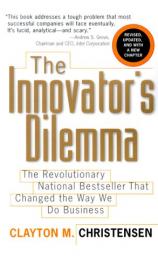Reading Group Guide
Discussion Questions
The Innovator's Dilemma

1.The characteristics of a disruptive technology are: They are simpler and cheaper and lower performing. They generally promise lower margins, not higher profits. Leading firms' most profitable customers generally can't use and don't want them. They are first commercialized in emerging or insignificant markets. The Innovators Dilemma discusses disruptive innovations in the disk-drive, excavator, steel and auto industries. Looking back through history, can you identify some disruptive technologies that eventually replaced older products and industries? Can you think of others that are emerging today, maybe even ones that could threaten your business?
2. There is a tendency in all markets for companies to move upmarket toward more complicated products with higher prices. Why is it difficult for companies to enter markets for simpler, cheaper products? Can you think of companies that have upscaled themselves out of business? How might they have avoided that?
3. The same tendency for companies to move upmarket that can be fatal for established companies also accounts for the eventual development of emerging markets into mainstream markets. Besides the examples in the book, can you think of companies that have upscaled themselves to success.
4. In attempting to commercialize a disruptive technology, why is it important to begin investing on the assumption that your expectations will be wrong? Besides the motorcycle, excavator and disk-drive examples in the book, can you think of other examples where a company began marketing a product for one application but the big market turned out to be for another application?
5. One of the hallmarks of disruptive technologies is that initially they underperform the current technology on the attributes that matter most to mainstream customers. The companies that succeed in commercializing them, therefore, must find different customers for whom the new technology's attributes are most valuable. Can you think of any markets that are emerging today based on attributes or qualities that seemed unimportant to the mainstream markets when they were introduced? What older, mainstream products or companies are threatened?
6. When two or more products meet the minimum specifications for the functionality of a product, customers begin to look for other deciding factors. According to a Windermere Associates study cited in the book, the progression usually is from functionality to reliability to convenience to price. What are some current markets that have recently moved one or more steps along this progression?
7. Most people think that senior executives make the important decisions about where a company will go and how it will invest its resources, but the real power lies with the people deeper in the organization who decide which proposals will be presented to senior management. What are the corporate factors that lead mid-level employees to ignore or kill disruptive technologies? Should well-managed companies change these practices and policies?
8. What are the personal career considerations that lead ambitious employees in large corporations to ignore or kill disruptive technologies? Should well-managed companies change the policies that encourage employees to think this way?
9. What do the findings in this book suggest about how companies will be organized in the future? Should large organizations with structures created around functionalities redesign themselves into interconnected teams, as some management theorists currently believe? Or, recognizing that different technologies and different markets have differing needs, should they try to have distinct organizational structures and management practices for different circumstances? Is this realistically possible?
10.The CEO of a disk drive maker is quoted in Chapter 4 as saying that "We got way ahead of the market" in explaining why his company failed to commercialize a 1.8-inch disk drive that it had developed. At the time, however, there was a burgeoning market for 1.8-inch drives among new users that his company hadn't discovered. Prof. Christensen's argues that "disruptive technology should be framed as a marketing challenge, not a technological one" Do you think there is a market somewhere for all technologies? If not, how would you as a manager go about figuring out which technologies to shelve and which ones to pursue aggressively?
11. Similarly, Prof. Christensen argues that companies should not wait for new breakthroughs to improve a technology's performance. Instead, they need to find customers who value the very attributes that others consider to be shortcomings. As a manager, how do you decide when a technology --or idea -- needs more development and when its time to aggressively put it on the market?
12.The primary thesis of The Innovator's Dilemma is that the management practices that allow companies to be leaders in mainstream markets are the same practices that cause them miss the opportunities offered by disruptive technologies. In other words, well-managed companies fail because they are well managed. Do you think that the definition of what constitutes "good management" is changing?. In the future, will listening to customers, investing aggressively in producing what those customers say they want, and carefully analyzing markets become "bad management." What kind of system might combine the best of both worlds?
The Innovator's Dilemma
- Publication Date: August 31, 2012
- Paperback: 320 pages
- Publisher: HarperCollins Publishers
- ISBN-10: 0066620694
- ISBN-13: 9780066620695







